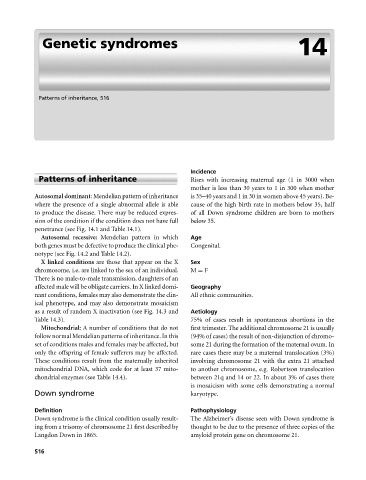Page 520 - Medicine and Surgery
P. 520
P1: KOA
BLUK007-14 BLUK007-Kendall May 11, 2005 17:53 Char Count= 0
Genetic syndromes 14
Patterns of inheritance, 516
Incidence
Patterns of inheritance Rises with increasing maternal age (1 in 3000 when
mother is less than 30 years to 1 in 300 when mother
Autosomal dominant:Mendelian pattern of inheritance is 35–40 years and 1 in 30 in women above 45 years). Be-
where the presence of a single abnormal allele is able cause of the high birth rate in mothers below 35, half
to produce the disease. There may be reduced expres- of all Down syndrome children are born to mothers
sion of the condition if the condition does not have full below 35.
penetrance (see Fig. 14.1 and Table 14.1).
Autosomal recessive: Mendelian pattern in which Age
both genes must be defective to produce the clinical phe- Congenital.
notype (see Fig. 14.2 and Table 14.2).
X linked conditions are those that appear on the X Sex
chromosome, i.e. are linked to the sex of an individual. M = F
There is no male-to-male transmission, daughters of an
affected male will be obligate carriers. In X linked domi- Geography
nant conditions, females may also demonstrate the clin- All ethnic communities.
ical phenotype, and may also demonstrate mosaicism
as a result of random X inactivation (see Fig. 14.3 and Aetiology
Table 14.3). 75% of cases result in spontaneous abortions in the
Mitochondrial: Anumber of conditions that do not first trimester. The additional chromosome 21 is usually
follow normal Mendelian patterns of inheritance. In this (94% of cases) the result of non-disjunction of chromo-
set of conditions males and females may be affected, but some 21 during the formation of the maternal ovum. In
only the offspring of female sufferers may be affected. rare cases there may be a maternal translocation (3%)
These conditions result from the maternally inherited involving chromosome 21 with the extra 21 attached
mitochondrial DNA, which code for at least 37 mito- to another chromosome, e.g. Robertson translocation
chondrial enzymes (see Table 14.4). between 21q and 14 or 22. In about 3% of cases there
is mosaicism with some cells demonstrating a normal
Down syndrome karyotype.
Definition Pathophysiology
Down syndrome is the clinical condition usually result- The Alzheimer’s disease seen with Down syndrome is
ing from a trisomy of chromosome 21 first described by thought to be due to the presence of three copies of the
Langdon Down in 1865. amyloid protein gene on chromosome 21.
516

